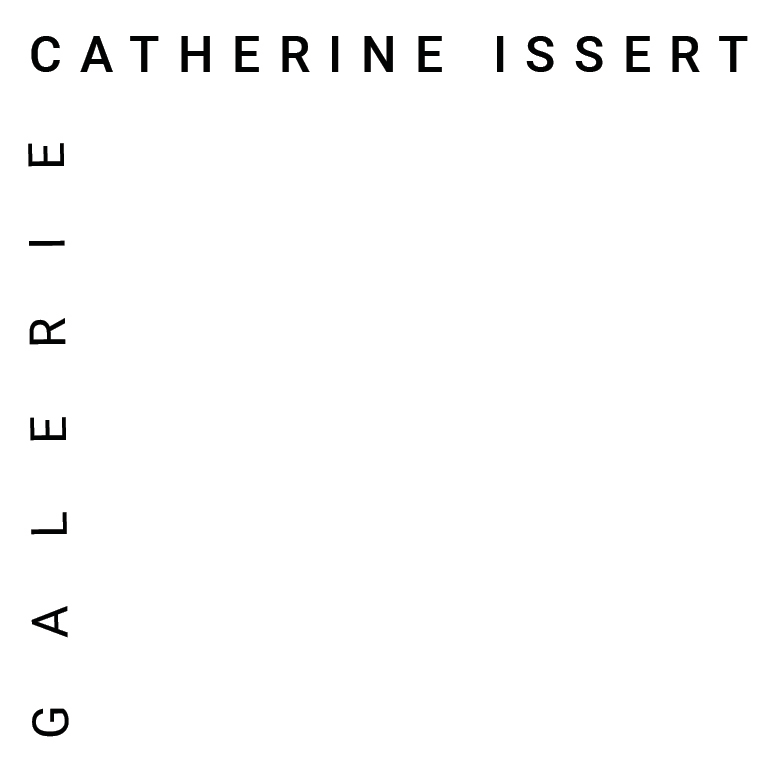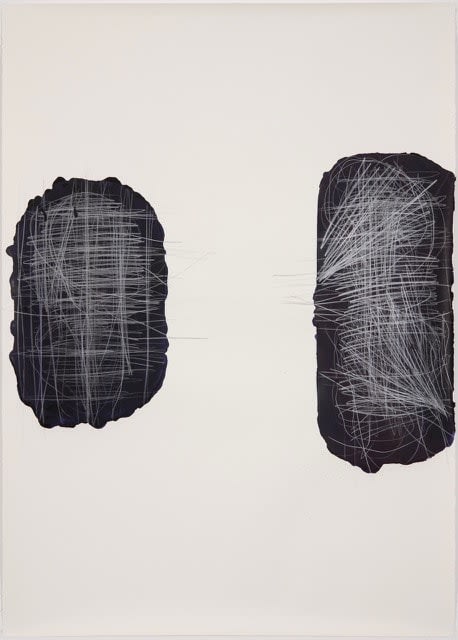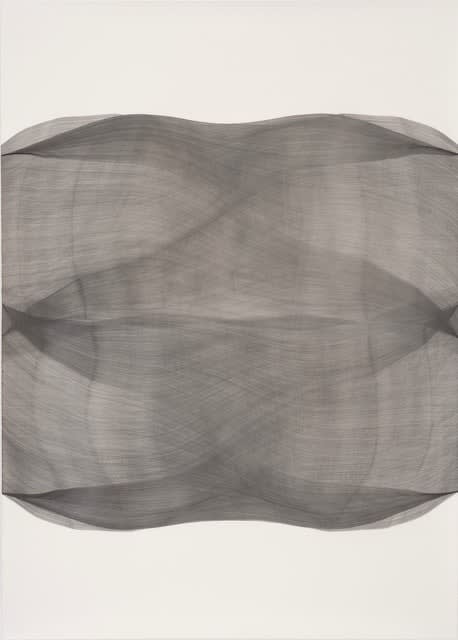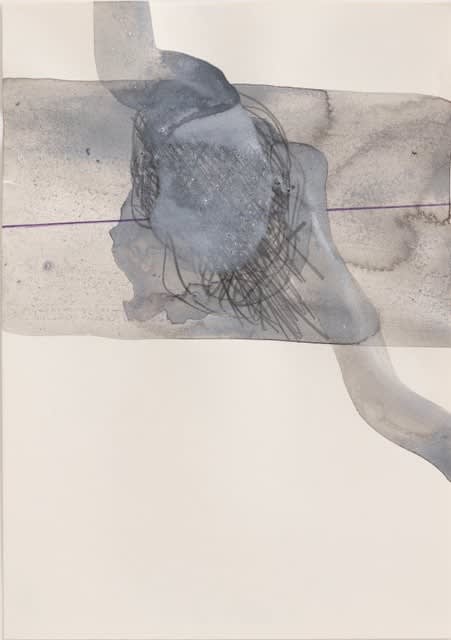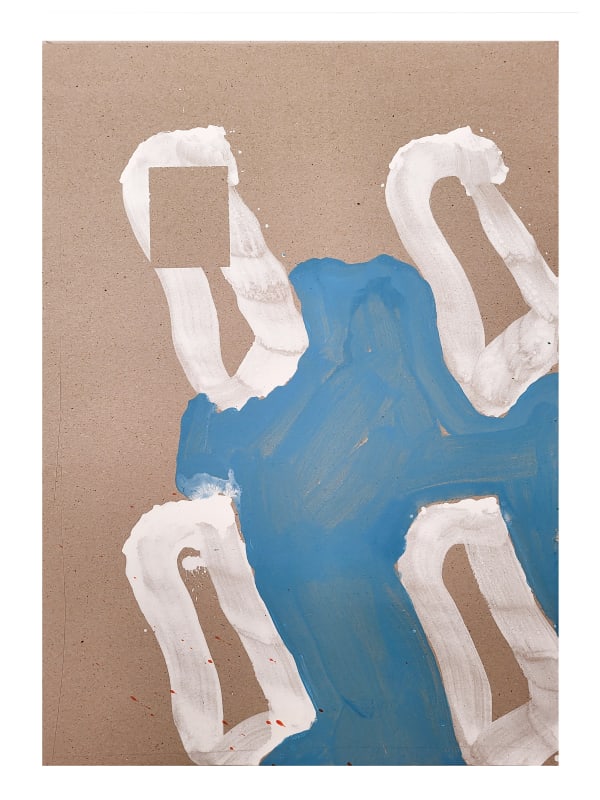-
 John ARMLEDERSans Titre, 198059,3 x 41,9 cm
John ARMLEDERSans Titre, 198059,3 x 41,9 cm
signé et daté au devant -
 John ARMLEDERLithosia Rubricollis, 202349,8 x 70 cm
John ARMLEDERLithosia Rubricollis, 202349,8 x 70 cm
signé et daté au devant -
 John ARMLEDERSpelothyrus Atheae , 202349,8 x 70 cm
John ARMLEDERSpelothyrus Atheae , 202349,8 x 70 cm
signé et daté au devant -
 Jean Michel ALBÉROLA, Sans titre, 2023
Jean Michel ALBÉROLA, Sans titre, 2023 -
 Jean Michel ALBÉROLA, Sans titre, 2022
Jean Michel ALBÉROLA, Sans titre, 2022 -
 Jean-Michel ALBEROLASans titre 27 05 2023 , 202263,5 x 50 cm
Jean-Michel ALBEROLASans titre 27 05 2023 , 202263,5 x 50 cm -
 Cécile BARTHumeur (v) #3 dominante jaune, 202251 x 36 cm
Cécile BARTHumeur (v) #3 dominante jaune, 202251 x 36 cm -
 Cécile BARTHumeur (v) #4 bleus et verts sombres, 202251 x 36 cm
Cécile BARTHumeur (v) #4 bleus et verts sombres, 202251 x 36 cm -
 Cécile BARTHumeur (v) #5 rose et dorés, 202251 x 36 cm
Cécile BARTHumeur (v) #5 rose et dorés, 202251 x 36 cm -
 Cécile BARTDessin/écran #3, 2022120 x 120 cm
Cécile BARTDessin/écran #3, 2022120 x 120 cm -
 Pierrette BLOCHSans titre, 198065 x 50 cm
Pierrette BLOCHSans titre, 198065 x 50 cm
Encadrement : 78 x 62,5 cm -
 Pierrette BLOCHSans titre, 200626 x 16,5 cm
Pierrette BLOCHSans titre, 200626 x 16,5 cm
Encadrement : 39 x 29 cm -
 Jean Charles BLAISSans Titre, 199442 x 28,8 cm
Jean Charles BLAISSans Titre, 199442 x 28,8 cm
Encadrement : 55 x 43 x 4 cm -
 Thomas MÜLLERSans titre , 2021160 x 115 cm
Thomas MÜLLERSans titre , 2021160 x 115 cm -
 Thomas MÜLLERSans titre , 2023214 x 153cm
Thomas MÜLLERSans titre , 2023214 x 153cm -
 Thomas MÜLLERSans titre , 202329,7 x 21 cm
Thomas MÜLLERSans titre , 202329,7 x 21 cm -
 Thomas MÜLLERSans titre , 202329,7 x 21 cm
Thomas MÜLLERSans titre , 202329,7 x 21 cm -
 Thomas MÜLLERSans titre , 202229,7 x 21 cm
Thomas MÜLLERSans titre , 202229,7 x 21 cm -
 Thomas MÜLLERSans titre , 202329,7 x 21 cm
Thomas MÜLLERSans titre , 202329,7 x 21 cm -
 Gérard TRAQUANDI, Sans Titre , 2010
Gérard TRAQUANDI, Sans Titre , 2010 -
 Gérard TRAQUANDISans Titre , 200897 x 66 cm
Gérard TRAQUANDISans Titre , 200897 x 66 cm -
 Gérard TRAQUANDI, Sans titre, 2023
Gérard TRAQUANDI, Sans titre, 2023 -
 Gérard TRAQUANDISans titre, 2023200 x 140 cm
Gérard TRAQUANDISans titre, 2023200 x 140 cm -
 Gérard TRAQUANDISans titre, 2023146 x 114 cm
Gérard TRAQUANDISans titre, 2023146 x 114 cm -
 Claude VIALLAT, Sans titre , 2023
Claude VIALLAT, Sans titre , 2023 -
 Claude VIALLATSans titre , 202350 x 40 cm
Claude VIALLATSans titre , 202350 x 40 cm -
 Claude VIALLAT, Sans titre , 2023
Claude VIALLAT, Sans titre , 2023 -
 Claude VIALLATSans titre , 2023124 x 60 cm
Claude VIALLATSans titre , 2023124 x 60 cm
003PP2023 -
 Claude VIALLATSans titre , 200524 x 18 cm
Claude VIALLATSans titre , 200524 x 18 cm -
 Claude VIALLATSans titre , 200524 x 18 cm
Claude VIALLATSans titre , 200524 x 18 cm
La tache est intimement liée à la peinture. Tour à tour concurrente ou alliée de la ligne, elle est un fait esthétique aux contours ductiles que le corpus hétérogène de la double exposition des galeries Catherine Issert et Zlotowski reflète très librement. S’étendant de 1950 à aujourd’hui, celui-ci réunit des œuvres de techniques variées impliquant différents types de procédures : touche, giclée, éclaboussure, coulure, salissure, empreinte, imprégnation, ou même impression photographique. Avec la modernité et les avant-gardes, la tache a acquis un statut canonique, qui a démultiplié ses possibilités et élargi son champ d’action à toutes sortes de subjectiles.
"Renverser la tache" : cette image paradoxale, voire absurde, reprend le geste maladroit qui renverse la tasse de café, laissant des traces indésirables… Elle offre une entrée en matière directe qui convient bien à notre affaire. Et quelle affaire ! Il serait évidemment insensé de vouloir épuiser les fonctions de cet élément plastique, au cœur même de la peinture, qui se caractérise par sa matérialité, tout en étant insaisissable. La tache nous mène au plus près de l’œuvre, de sa genèse comme de son secret. En nous appuyant sur un corpus pluriel, on évoquera des procédures qui tantôt se distinguent, tantôt s’associent les unes aux autres. Quelques thèmes saillants vont nous guider dans notre déambulation : l’informe, la touche-tache (Macchiato), l’éclaboussure (Splash), l’inconscient (La tache pulsionnelle), le rythme (La tache à la ligne), La tache sans attache.
Néanmoins, en remuant la tache en plusieurs sens, en l’utilisant comme point de vue, comme œil, il semblerait qu’à travers les siècles, un trait, persistant, se dégage : la tache est liée au mouvement de la vie ou de la nature. Pour Léonard de Vinci ou Alexandre Cozens, elle met en mouvement l’imagination et stimule l’invention ; chez les grands maîtres de la touche, elle fait vibrer la représentation, insuffle de la vie, mais défie la forme ; projetée, elle capte et transmet une énergie cinétique. Sans aucun doute, Pierrette Bloch donne-t-elle un tour nouveau, léger et profond, à la tache qu’elle émancipe et fait danser sur des lignes invisibles. Ses alignements de taches, de points, de boucles, si simples, si réjouissants, offrent une vision à la fois épurée et rythmique d’un geste pictural essentiel.
Anne Bonnin
Critique d'art et commissaire d'exposition.
________________________________________________
Stains are intimately linked to painting. Alternately competitors or allies of the line, they are aesthetic facts with ductile contours. This is very freely reflected by the heterogeneous body of work in the double exhibition at the Catherine Issert and Zlotowski galleries. Spanning the period from 1950 to the present day, the exhibition brings together mixed-technique works involving different procedures: strokes, jets, splashes, drips, blots, imprints, permeations and even photographic prints. With modernity and the avant-gardes, the stain acquired a canonical status, which multiplied its possibilities and extended its field of action to all kinds of substrates.
“Spilling the stain”: this paradoxical, even absurd image evokes the clumsy gesture of spilling a cup of coffee, leaving unwanted marks... It offers a direct introduction that is well suited to our subject. And what a subject it is! It would obviously be pointless to attempt to exhaust the functions of this visual element, located at the very heart of painting, characterised by its materiality whilst simultaneously remaining elusive. The stain takes us to the heart of the work, to its genesis and its secret. Drawing on a diverse body of work, we will explore procedures that are both distinct and interrelated. A few salient themes will guide us on our journey: formlessness, the stroke-stain (Macchiato), the splash (Splash), the unconscious (The instinctual stain), rhythm (The stain on the line), The untethered stain.
Nevertheless, by moving the stain in several directions, by using it as a point of view, as an eye, it would seem that a persistent trait has emerged throughout the centuries: the stain is associated with the movement of life and nature. For Leonardo da Vinci or Alexandre Cozens, it set the imagination in motion and stimulated invention; for the great master craftsmen of the brushstroke, it made the representation vibrate, breathed life into it, but defied form; projected, it captures and transmits a kinetic energy. Pierrette Bloch undoubtedly gave a new twist, both playful and profound, to the stain, which she emancipated and made dance on invisible lines. Her simple, delightful alignments of spots, dots and loops offer a vision of an essential pictorial gesture that is both refined and rhythmic.
-
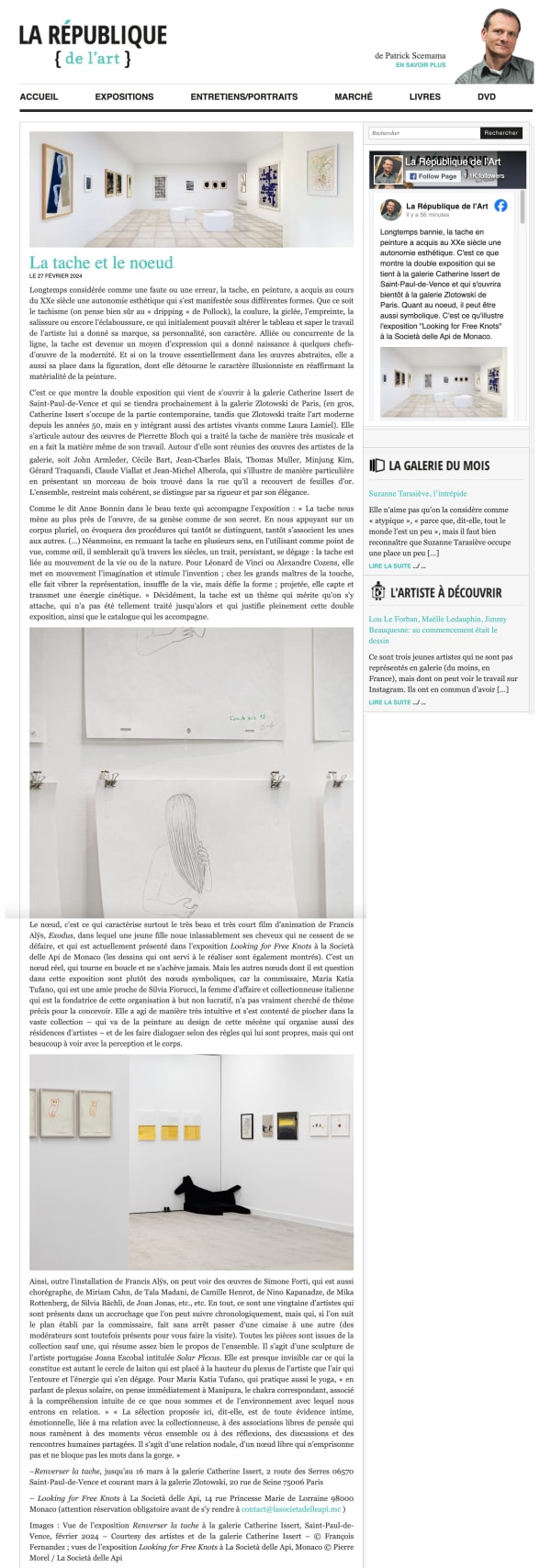
LA RÉPUBLIQUE DE L'ART
Par Patrick SCEMAMAPar Patrick SCEMAMA, LA RÉPUBLIQUE DE L'ART , February 27, 2024
